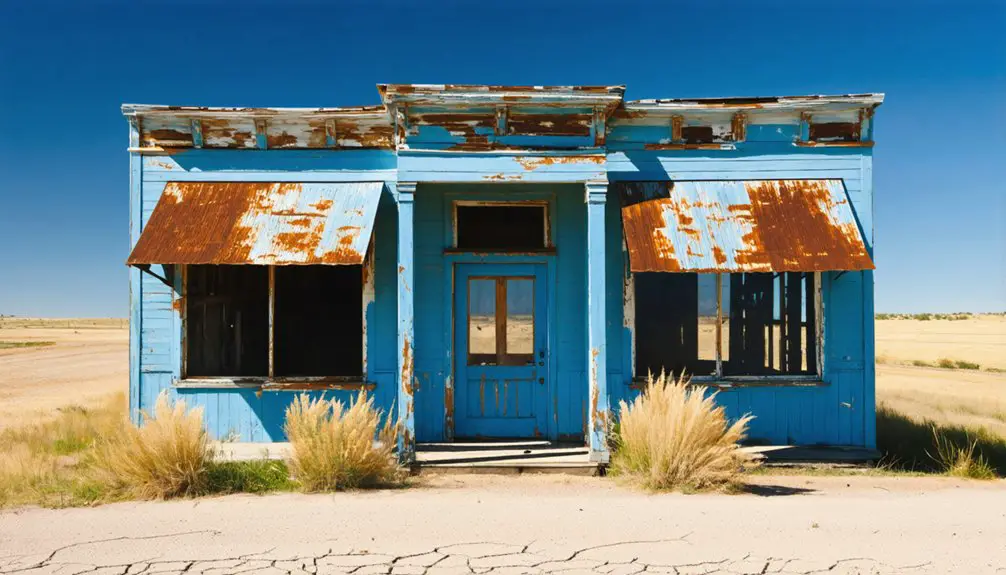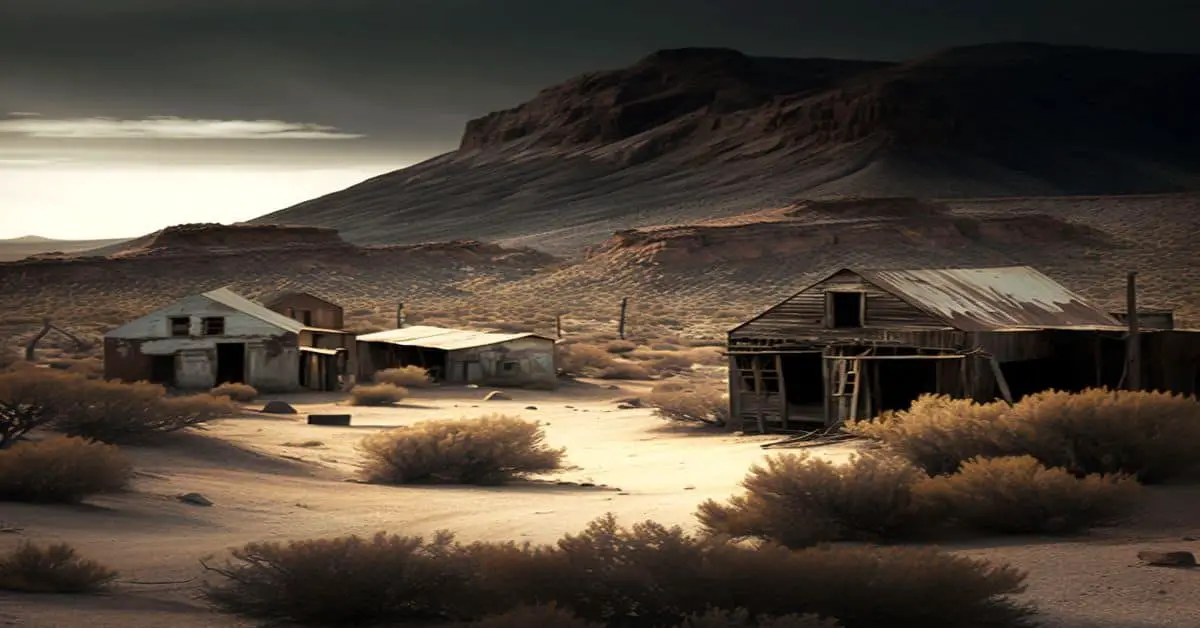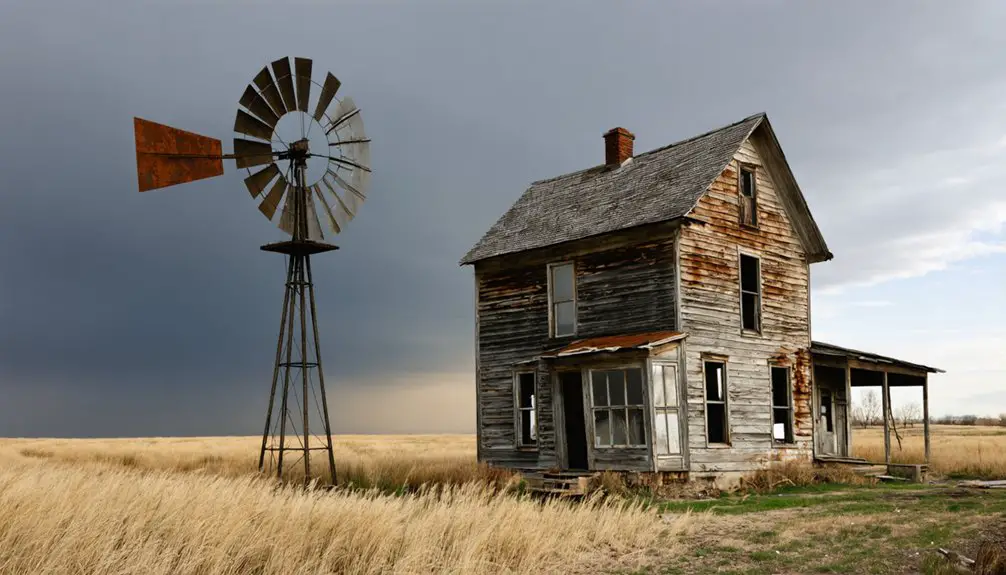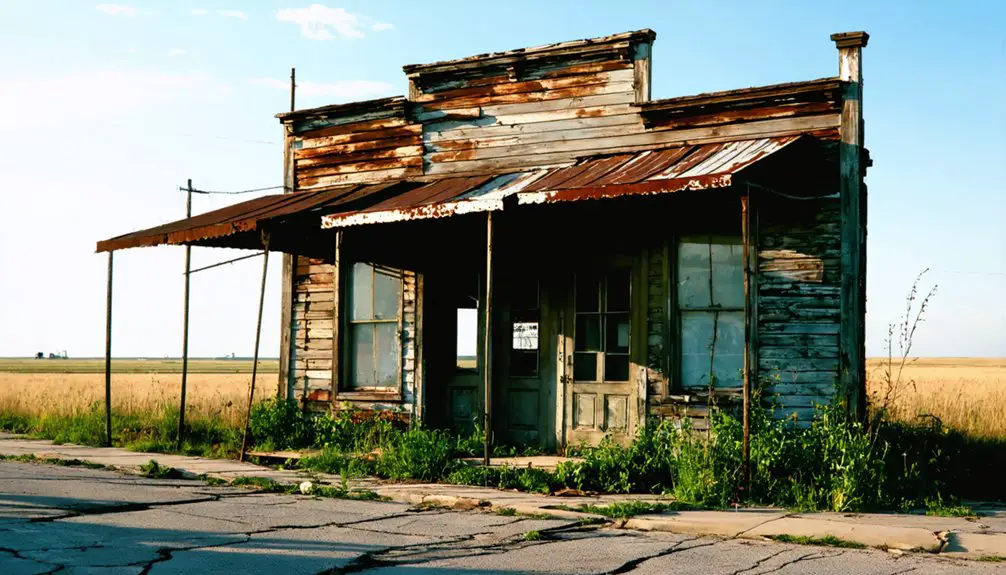You’ll find Duff nestled in southern Rock County, Nebraska, where mixed-grass prairie and winding creeks shaped this ambitious 1850s settlement. The town’s heart centered around its E.U.B. Church, District 4 school, and local store that served as community anchors. Though most buildings are gone now, concrete foundations and wooden church pews remain as silent witnesses to Duff’s vibrant past – each artifact holding untold stories of prairie life and persistence.
Key Takeaways
- Duff was a small community in southern Rock County, Nebraska, established in the late 1850s near Bloody and Skull creeks.
- The town’s main institutions included a school, bank, post office (established 1892), and Evangelical United Brethren Church.
- Commercial activity centered around a single store building, which later transformed into a church after the original store burned down.
- The community gradually transformed into a ghost town through the mid-20th century, marked by the church’s merger with Rose Hill in 1962.
- Concrete foundations, wooden church pews, and agricultural remnants remain as physical evidence of Duff’s former existence.
The Birth of a Prairie Settlement
As Nebraska Territory opened its frontier to settlers in the late 1850s, the small prairie settlement of Duff emerged amid a broader wave of community development across the region.
You’ll find its roots deeply embedded in the settlement dynamics that shaped southern Rock County, where pioneers sought opportunities in the mixed-grass prairie’s Sandhill valleys. Located in a broad valley, the area was drained by the Bloody and Skull creeks that gave the region its original name.
Like many frontier towns, Duff faced environmental challenges typical of prairie life. While the relatively flat terrain proved suitable for farming, settlers had to adapt to the realities of drought and limited timber resources.
Prairie settlers confronted harsh realities of their environment, making do with scarce resources while adapting to nature’s persistent challenges.
They’d find creative solutions, using local materials like brick and stone for construction. The town’s modest beginnings reflected the practical needs of its agricultural community rather than the speculative ambitions that drove some of Nebraska’s “boom paper” towns. The region’s development was influenced by the estimated 500,000 westward travelers who passed through Nebraska Territory between 1841 and 1866.
Life in Early Duff
While the rhythms of prairie life shaped much of early Duff’s character, you’ll find its social fabric was woven through three main institutions: the Duff Valley District 4 school, the local bank, and the post office established in 1892.
The education history of Duff centered around the original schoolhouse, positioned three miles west and one mile south of Highway 183. You’d discover preserved attendance records in the school’s attic, reflecting strong community values around learning. Like many rural schools across Nebraska, the institution provided vital education to children of homesteading families who acquired free land from the federal government.
The bank building, which later became the Horner family’s residence, served as a symbol of the town’s economic aspirations. The post office, operating intermittently until 1953, connected residents to the outside world. To avoid confusion with other locations named Duff, locals often used clear navigation aids when providing directions to visitors.
Situated in the broad Sandhill valley near Bloody and Skull creeks, Duff’s institutions fostered a close-knit prairie community adapting to the challenges of rural life.
The Heart of Community Worship
You’ll find that Duff’s Evangelical United Brethren Church, though housed in a converted storefront, served as more than just a place of worship for this rural Nebraska community.
The small congregation of around 30 members gathered in wooden pews along a central aisle, sharing hymns accompanied by piano and taking communion at a memorial table inscribed with “In Remembrance of Me.”
As documented in church records, when the Duff church was merged with Rose Hill in 1962, its remaining members continued their spiritual journey at the larger Rose Hill location.
Like the Ladies Aid Society that supported charitable causes in Cedar Creek, the congregation actively participated in community service projects. While denominations varied among local residents, with some attending Methodist or Catholic services elsewhere, the Duff church remained a crucial community anchor until its merger with Rose Hill in 1962.
Church as Social Hub
During the mid-20th century, the Duff Evangelical United Brethren Church stood as more than just a place of worship – it served as the beating heart of this small Nebraska community.
In a region where neighbors were spread far apart, you’d find the church room alive with community gatherings and social activities, drawing about 30 people on good Sundays. Like the early Denver stone cutter David Seerie who helped build significant community structures, the church played a vital role in bringing people together.
The spacious front room of the former store building, with its wooden pews and central aisle, provided an intimate setting where you could connect with fellow residents.
Under Pastor Harold Koelling‘s leadership, the church fostered essential social bonds through shared worship, music, and communal events.
Even after its 1962 consolidation with Rose E.U.B., the building remained a powerful symbol of the community’s shared heritage and cultural identity.
This religious adaptation reflected broader patterns in ghost town survival.
While Methodist and Catholic families worshipped elsewhere, the E.U.B. congregation of about 30 people maintained their communal identity through shared sacred space.
Much like Venus’s post office, which served as a community anchor for many years, the church remained a vital gathering point for local residents.
By 1962, declining population led to consolidation with the nearby Rose E.U.B. church.
The arrangement wasn’t unique – their pastor, Brother Harold Koelling, shepherded three congregations, showcasing how rural communities preserved their spiritual life through resourceful sharing.
Faith Beyond Buildings
While physical structures in Duff gradually succumbed to time and declining population, the spirit of community worship proved far more resilient.
You’ll find evidence of this spiritual resilience in how the congregation adapted when their dedicated church building closed – moving services into a former store and continuing to gather in whatever space was available.
Even with just 30 congregants on a good Sunday, adaptive worship remained vibrant through the mid-20th century.
The community preserved sacred objects like the memorial-inscribed communion table and maintained their musical traditions with a piano.
When the E.U.B. Church finally consolidated with Rose Church in 1962, it wasn’t an end to faith but a practical evolution.
The people of Duff showed that true worship transcends brick and mortar.
Much like the Duff Green Mansion’s role as a Civil War hospital, the community adapted their spaces to serve higher purposes.
Commerce and Daily Living

Located about 4 miles west of Highway 183, Duff’s commercial heart centered around a single store that served as the community’s lifeline for dry goods and groceries.
This store, along with the post office established in 1892, formed the backbone of the local economy, providing daily essentials to area farmers and residents.
You’d have found the storekeeper’s quarters attached to the same building where Forest Saar later lived.
While a previous store had burned down, leaving only its concrete cellar visible in a nearby pasture, the newer store building proved versatile – eventually becoming the meeting place for the E.U.B. Church after commercial operations ceased.
Footprints of the Past
Physical traces of Duff’s history remain scattered across the Nebraska prairie, telling stories of commerce and faith through concrete foundations and sacred artifacts.
You’ll find a concrete cellar where the original store once stood before fire claimed it, while the communion table inscribed with “In Remembrance of Me” preserves the spirit of community worship.
Unlike many ghost town myths that suggest sudden abandonment, Duff’s transformation into a ghost town happened gradually through the mid-20th century.
At coordinates 42.20250°N 99.60417°W, historical preservation efforts have documented these remaining structures and religious artifacts, though they’re becoming increasingly sparse.
The wooden pews and store foundations stand as silent witnesses to a once-thriving rural community that slowly faded into Nebraska’s landscape.
Legacy of a Lost Town
If you visit Duff today, you’ll find a rural time capsule where the old store-turned-church building stands as a symbol of the community’s adaptability and faith.
The “In Remembrance of Me” communion table and Arthur Zlomke’s memorial inside the church preserve the spiritual legacy of a congregation that once gathered 30 strong on Sundays.
The surrounding farmland continues to echo Duff’s agricultural heritage, even as the physical structures slowly fade into Nebraska’s prairie landscape. Like Indian Cave State Park, the area attracts visitors interested in exploring Nebraska’s rich historical landmarks.
Rural Community Time Capsule
Three significant artifacts stand as silent witnesses to Duff’s bygone era: a repurposed store building, a concrete cellar from a burned-down shop, and the E.U.B. Church.
These remnants tell the story of community memories and rural traditions that once thrived in this Nebraska settlement. You’ll find traces of a close-knit society where about 30 worshippers gathered each Sunday, sharing their faith and daily lives.
- The church’s communion table, inscribed with “In Remembrance of Me,” preserves personal legacies.
- Living quarters attached to the store reveal how commerce and home life intertwined.
- Wooden pews, a pulpit, and piano showcase the church’s role as a social hub.
- The concrete cellar stands as evidence to the town’s economic resilience after fire.
Church’s Lasting Memory
Legacy echoes through the E.U.B. church of Duff, where you’ll find stories etched in both memory and memorial significance. The communion table, inscribed with “In Remembrance of Me” and dedicated to Arthur Zlomke, stands as a symbol of the deep personal connections that defined this rural congregation.
You can trace the communal legacy through written accounts of Sunday gatherings, where up to 30 faithful would fill wooden pews in what was once a simple storefront.
While the 1962 consolidation with Rose church marked the end of an era, the spirit of Duff’s religious life hasn’t faded. Through historical documentation and preserved memories, you’re still able to glimpse the essential role this church played in binding together scattered families across the Nebraska countryside.
Agricultural Heritage Lives On
Nestled in a fertile Sandhill valley between Bloody and Skull creeks, Duff’s agricultural roots run deep through Nebraska’s soil and history.
Even though the town’s buildings have faded away, you’ll find the spirit of agricultural sustainability thriving in the surrounding farmlands that once supported this frontier community.
- Original farming traditions live on through intergenerational families who still work the productive soil.
- The valley’s rich terrain continues supporting crops, preserving Duff’s agricultural legacy.
- Former infrastructure like Duff Road still serves modern farmers, connecting them to regional markets.
- Historical records from the school and post office chronicle the area’s enduring connection to farming.
You can trace Duff’s lasting impact in today’s local farming practices, place names, and the determined spirit of Nebraska’s agricultural community.
Frequently Asked Questions
What Happened to the Families Who Lived in Duff After Its Decline?
You’ll find family legacies scattered as residents moved to nearby towns and cities for better opportunities, while descendant stories reveal how younger generations pursued education and jobs elsewhere, rarely returning home.
Are There Any Surviving Photographs of Duff During Its Active Years?
While traces of the past beckon, you won’t find clear historical documentation of this once-bustling community’s peak years. No confirmed photographic evidence exists from when the streets were alive.
What Natural Disasters or Weather Events Impacted Duff’s Development?
You’ll find drought effects severely challenged growth in the Sandhills region, while fire destroyed key buildings. Though tornado impacts aren’t specifically documented, Nebraska’s harsh weather patterns constantly threatened development.
Did Any Notable Crimes or Incidents Occur in Duff’s History?
You won’t find any unsolved mysteries or local legends about major crimes here – historical records show no notable criminal incidents, just the peaceful existence of a small rural community.
Can Visitors Legally Explore the Remaining Structures in Duff Today?
Look before you leap – you can’t legally explore ghost town structures without proper permissions. Current regulations require explicit landowner consent, and unauthorized exploration constitutes trespassing, potentially resulting in legal consequences.
References
- https://hauntedhouses.com/mississippi/duff-green-mansion/
- http://prairiebluestem.blogspot.com/2008/05/some-memories-of-duff-nebraska.html
- https://en.wikipedia.org/wiki/Duff
- https://visitnebraska.com/trip-idea/explore-7-authentic-ghost-towns-nebraska
- https://www.youtube.com/watch?v=l3s2qhSxis8
- https://www.youtube.com/watch?v=redtU6GT-BY
- https://history.nebraska.gov/wp-content/uploads/2017/12/doc_publications_NH1937GhostTowns.pdf
- https://www.americanheritage.com/ghost-town-river
- https://nebraskacityne.gov/history-of-nebraska-city/
- https://custercountyne.gov/webpages/about/history.html



